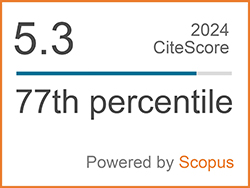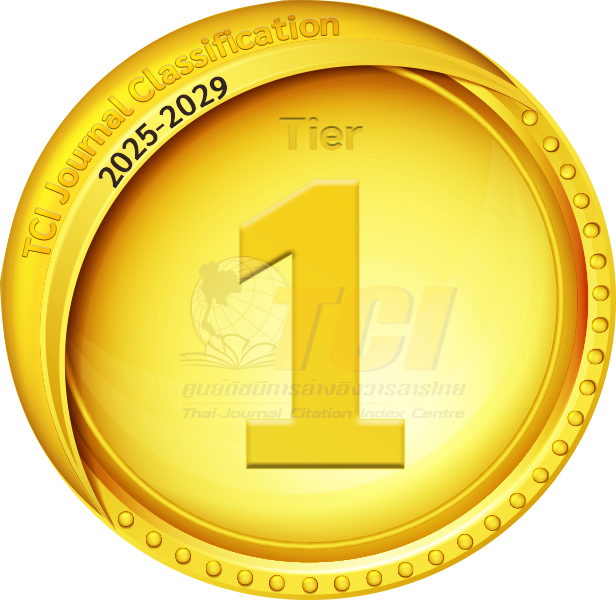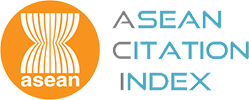Engineering Perspectives on Drying Technologies of Medicinal Plants: A Review on Kinetic Modelling and Bioactive Compounds Retention
Abstract
Medicinal plants, an integral part of the Indian traditional medicinal practices, are a reservoir of bioactive molecules proven to have therapeutic effects against various ailments. The post-harvest losses of medicinal plants have been estimated to range between 10-40% in Asian countries, including India, mainly due to improper handling, storage and packaging. Drying is an important post-harvest operation of plant materials that can significantly impact the functional bioactive compounds. This review aims to shed light on the various drying methodologies of medicinal plants, weighing their merits and limitations, and highlighting the latest advancements and current research. The review summarizes the influence of drying parameters on the stability and retention of bioactive compounds in medicinal plants, as well as focuses on the drying kinetic models employed to comprehend their moisture transport mechanism. In conclusion, the authors intend to address the major challenges and research gaps to offer insights for advancing research in improving the herbal drug quality through optimized drying conditions.
Keywords
[1] M. Prasathkumar, S. Anisha, C. Dhrisya, R. Becky, and S. Sadhasivam, “Therapeutic and pharmacological efficacy of selective Indian medicinal plants – A review,” Phytomedicine Plus, vol. 1, no. 2, May 2021, doi: 10.1016/ j.phyplu.2021.100029.
[2] R. Panmei, P. R. Gajurel, and B. Singh, “Ethnobotany of medicinal plants used by the Zeliangrong ethnic group of Manipur, northeast India,” Journal of Ethnopharmacology, vol. 235, pp. 164–182, May 2019, doi: 10.1016/j.jep. 2019.02.009.
[3] B. R. Rao and D. Rajput, “Global Scenario of medicinal plants.” csii.res.in. Accessed: Jan 10, 2025. [Online.] Available: http://www.csii.res.in
[4] T. S. S. B. Rao and S. Murugan, “Solar drying of medicinal herbs: A review,” Solar Energy, vol. 223, pp. 415–436, Jul. 2021, doi: 10.1016/ j.solener.2021.05.065.
[5] D. Kohli, P. S. Champawat, S. K. Jain, V. D. Mudgal, and N. C. Shahi, “Mathematical modelling for drying kinetics of asparagus roots (Asparagus racemosus l.) and determination of energy consumption,” Biointerface Research in Applied Chemistry, vol. 12, no. 3, pp. 3572–3589, 2022, doi: 10.33263/BRIAC123.35723589.
[6] J. Müller and A. Heindl, “Drying of medicinal plants,” in Medicinal and Aromatic Plants: Agricultural, Commercial, Ecological, Legal, Pharmacological and Social Aspects, New York: Springer, 2006, pp. 237–252.
[7] C. Kumar and M. A. Karim, “Microwave-convective drying of food materials: A critical review,” Critical Reviews in Food Science and Nutrition, vol. 59, no. 3, pp. 379–394, 2019.
[8] S. V. Gupta and N. Patil, “Convective drying of osmo-dehydrated sapota slice,” International Journal of Agricultural and Food Science, vol. 5, no. 3, pp. 219–226, 2014.
[9] A. Waman and P. Bohra, “Sustainable development of medicinal and aromatic plants sector in India: An overview,” Science and Culture, vol. 82, pp. 245–250, Jan. 2016.
[10] V. T. Nguyen, Q. V. Vuong, M. C. Bowyer, I. A. V. Altena, and C. J. Scarlett, “Effects of different drying methods on bioactive compound yield and antioxidant capacity of Phyllanthus amarus,” Drying Technology, vol. 33, no. 8, pp. 1006–1017, Jun. 2015, doi: 10.1080/07373937. 2015.1013197.
[11] B. M. Padhiari, A. Ray, S. Jena, B. B. Champati, A. Sahoo, T. Halder, B. Ghosh, P. C. Panda, and S. Nayak, “Effect of different drying treatments on the physicochemical, functional, and antioxidant properties of Bacopa monnieri,” BioTechnologia, vol. 102, no. 4, pp. 399–409, 2021, doi: 10.5114/bta.2021.111105.
[12] Z. Y. Gnativ, O. S. Ivashchuk, Y. M. Hrynchuk, V. V. Reutskyi, I. Z. Koval, and Y. Z. Vashkurak, “Modeling of internal diffusion mass transfer during filtration drying of capillary-porous material,” Mathematical Modeling and Computing, vol. 7, no. 1, pp. 22–28, 2020, doi: 10.23939/mmc2020.01.022.
[13] F. H. C. Vera, A. N. Soriano, N. P. Dugos, and R. V. C. Rubi, “A comprehensive review on the drying kinetics of common tubers,” Applied Science and Engineering Progress, vol. 14, no. 2, pp. 146–155, Apr. 2021, doi: 10.14416/j.asep. 2021.03.003.
[14] A. Kamarulzaman, M. Hasanuzzaman, and N. A. Rahim, “Global advancement of solar drying technologies and its future prospects: A review,” Solar Energy, vol. 221, pp. 559–582, Jun. 2021, doi: 10.1016/j.solener.2021.04.056.
[15] A. Jha and P. P. Tripathy, “Recent advancements in design, application, and simulation studies of hybrid solar drying technology,” Food Engineering Reviews, vol. 13, no. 2, pp. 375–410, Jun. 2021, doi: 10.1007/s12393-020-09223-2.
[16] A. R. Hande, S. B. Swami, and N. J. Thakor, “Open-air sun drying of kokum (Garcinia indica) rind and its quality evaluation,” Agricultural Research, vol. 5, no. 4, pp. 373–383, 2016.
[17] A. C. Iwansyah, T. D. Manh, Y. Andriana, M. A Hessan, F. Kormin, D. X. Cuong, N. X. Hoan, H. T. Ha, D. T. Yen, P. V. Thinh, and L. T. Hai, “Effects of various drying methods on selected physical and antioxidant properties of extracts from Moringa oliefera leaf waste,” Sustainability, vol. 12, no. 20, pp. 8586–8586, Oct. 2020, doi: 10.3390/su12208586.
[18] L. Wiset, N. Poomsa-ad, H. Jindamol, A. Thongtip, K. Mosaleeyanon, T. Toojinda, C. T. Darwell, T. B. Saputro, and P. Chutimanukul, “Quality and bioactive compound accumulation in two holy basil cultivars as affected by microwave-assisted hot air drying at an industrial scale,” Frontiers in Sustainable Food Systems, vol. 7, 2023, Art. no. 1219540, doi: 10.3389/ fsufs.2023.1219540.
[19] A. Al-Hamdani, H. Jayasuriya, P. B. Pathare, and Z. Al-Attabi, “Drying characteristics and quality analysis of medicinal herbs dried by an indirect solar dryer,” Foods, vol. 11, no. 24, pp. 4103–4103, Dec. 2022, doi: 10.3390/foods11244103.
[20] M. R. Wylie and D. S. Merrell, “The antimicrobial potential of the neem tree Azadirachta indica,” Frontiers in Pharmacology, vol. 13, pp. 891535- 891535, May 2022, doi: 10.3389/fphar.2022. 891535.
[21] K. M. Manju, Rekha, Priyanka, and N. Kumar, “Effect of fluidized‐bed and freeze‐drying techniques on physicochemical, nutritional, thermal, and structural properties of Moringa oleifera flowers, leaves, and seeds,” Journal of Food Processing and Preservation, vol. 45, no. 9, pp. 15719–15719, Sep. 2021, doi: 10.1111/jfpp. 15719.
[22] A. Sozzi, M. Zambon, G. Mazza, and D. Salvatori, “Fluidized bed drying of blackberry wastes: Drying kinetics, particle characterization and nutritional value of the obtained granular solids,” Powder Technology, vol. 385, pp. 37–49, Jun 2021.
[23] A. Korkmaz, E. Arslan, and M. Koşan, “Volatile compounds, bioactive properties and chlorophyll contents in dried spearmint (Mentha spicata L.) as affected by different drying methods,” Journal of Agricultural Sciences, vol. 29, no. 2, pp. 604–617, 2023.
[24] A. K. Senapati, P. S. Rao, and S. Prasad, “Optimization of process parameters for convective-microwave drying of ashwagandha roots,” International Journal of Engineering Research and Applications, vol. 4, pp. 168–189, 2014.
[25] D. Wray and H. S. Ramaswamy, “Novel concepts in microwave drying of foods,” Drying Technology, vol. 33, no. 7, pp. 769–783, May 2015, doi: 10.1080/07373937.2014.985793.
[26] J. Branisa, K. Jomova, M. Porubska, V. Kollar, M. Simunkova, and M. Valko, “Effect of drying methods on the content of natural pigments and antioxidant capacity in extracts from medicinal plants: A spectroscopic study,” Chemical Papers, vol. 71, no. 10, pp. 1993–2002, Oct. 2017, doi: 10.1007/s11696-017-0193-9.
[27] K. Ç. Selvi, A. Kabutey, G. A. K. Gürdil, D. Herak, Ş. Kurhan, and P. Klouček, “The effect of infrared drying on color, projected area, drying time, and total phenolic content of rose (Rose electron) petals,” Plants, vol. 9, no. 2, pp. 236–236, Feb. 2020, doi: 10.3390/plants9020236.
[28] K. Krishnamurthy, H. K. Khurana, J. Soojin, J. Irudayaraj, and A. Demirci, “Infrared heating in food processing: An overview,” Comprehensive Reviews in Food Science and Food Safety, vol. 7, no. 1, pp. 2–13, Jan. 2008, doi: 10.1111/j.1541-4337.2007.00024.x.
[29] X. Huang, W. Li, Y. Wang, and F. Wan, “Drying characteristics and quality of Stevia rebaudiana leaves by far-infrared radiation,” LWT, vol. 140, 2021, Art. no. 110638.
[30] W. Ma, Z. Zang, B. Wu, G. Ma, F. Wan, Y. Xu, and X. Huang, “Effect of radio frequency vacuum drying on drying characteristics and physicochemical quality of Codonopsis pilosula slices,” Agriculture, vol. 14, no. 9, pp. 1495, 2024.
[31] C. Acar, I. Dincer, and A. Mujumdar, “A comprehensive review of recent advances in renewable-based drying technologies for a sustainable future,” Drying Technology, vol. 40, no. 6, pp. 1029–1050, 2022.
[32] N. Cunha, L. H. M. Silva, and A. M. C Rodrigues, “Drying of Curcuma longa L. slices by refractance window: Effect of temperature on thermodynamic properties and mass transfer parameters,” Heat and Mass Transfer, vol. 60, no. 4, pp. 617–626, 2024.
[33] A. N. Kumar, A. Sneha, K. S. Srinivas, G. K. Babu, J. K. Kumar, M. V. Kumar, A. C. Jnanesha, and K. Vinutha,“Optimisation of harvesting time and drying techniques for higher sennosides in Cassia angustifolia Vahl. by RP-HPLC,” Industrial Crops and Products, vol. 197, pp. 116591–116591, Jul. 2023, doi: 10.1016/ j.indcrop.2023.116591.
[34] U. E. Inyang, I. O. Oboh, and B. R. Etuk, “Kinetic models for drying techniques—food materials,” Advances in Chemical Engineering and Science, vol. 08, no. 02, pp. 27–48, 2018, doi: 10.4236/aces.2018.82003.
[35] D. S. A. Delfiya, K. Prashob, S. Murali, P. V. Alfiya, M. P. Samuel, and R. Pandiselvam, “Drying kinetics of food materials in infrared radiation drying: A review,” Journal of Food Process Engineering, vol. 45, no. 6, pp. 13810-13810, Jun. 2022, doi: 10.1111/jfpe.13810.
[36] M. Moradi, M. Niakousari, and A. M. Khaneghah, “Kinetics and mathematical modeling of thin layer drying of osmo‐treated aloe vera (Aloe barbadensis) gel slices,” Journal of Food Process Engineering, vol. 42, no. 6, pp. 13180–13180, Oct. 2019, doi: 10.1111/jfpe. 13180.45.
[37] J. Crank, The Mathematics of Diffusion. Oxford, UK: Clarendon Press, 1975, p. 414.
[38] P. L. Singh and S. Singh, “Amla (Emblica officinalis) drying in solar-assisted heat pump dryer,” International Energy Journal, vol. 12, no. 4, pp. 253–262, Dec. 2011.
[39] H. S. Kusuma, D. N. Izzah, and I. W. L. Linggajati, “Microwave-assisted drying of Ocimum sanctum leaves: Analysis of moisture content, drying kinetic model, and techno-economics,” Applied Food Research, vol. 3, no. 2, Dec. 2023, Art. no. 100337, doi: 10.1016/j.afres. 2023.100337.
[40] N. B. Ma, T. T. H. Le, and N. L. Le, “Drying kinetics, rehydration behavior and morphological properties of pre-blanched thai basil leaves,” Applied Science and Engineering Progress, vol. 15, no. 4, 2022, Art. no. 5557.
[41] V. Chaudhary, V. Kumar, B. R. Singh, J. Singh, N. Chauhan, and P. Kumar, “Drying characteristics of bael pulp using different drying methods and different varieties,” International Journal of Agricultural Engineering, vol. 13, no. 1, pp. 19–30, Apr. 2020, doi: 10.15740/HAS/IJAE/ 13.1/19-30.
[42] A. Sharma, P. S. Champawat, S. Suman, K. Meghwal, and N. Prajapat, “Drying characteristics of bael fruit (aegle marmelos) pulp in mechanical tray dryer,” International Journal of Current Microbiology and Applied Sciences, vol. 9, no. 8, pp. 922–935, Aug. 2020, doi: 10.20546/ijcmas.2020.908.100.
[43] Z. Parhizi, H. Karami, I. Golpour , M. Kaveh, M. Szymanek, A.M.B Marigorta, J. D. Marcos, E. Khalife, S. Skowron, N. A. Othman, and Y. Darvishi, “Modeling and optimization of energy and exergy parameters of a hybrid-solar dryer for basil leaf drying using RSM,” Sustainability, vol. 14, no. 14, pp. 8839–8839, Jul. 2022, doi: 10.3390/su14148839.
[44] A. Vega, E. Uribe, R. Lemus, and M. Miranda, “Hot-air drying characteristics of aloe vera (Aloe barbadensis Miller) and influence of temperature on kinetic parameters,” LWT - Food Science and Technology, vol. 40, no. 10, pp. 1698–1707, Dec. 2007, doi: 10.1016/j.lwt.2007. 01.001.
[45] P. Nimnuan and S. Nabnean, “Solar drying of galangal slices (Alpinia Galangal (Linn.) Swartz.) using household solar dryer,” Suranaree Journal of Science and Technology, vol. 27, no. 4, pp. 1–8, Dec. 2020.
[46] A. Namkanisorn and S. Murathathunyaluk, “Sustainable drying of galangal through combination of low relative humidity, temperature and air velocity,” Energy Reports, vol. 6, pp. 748–753, Feb. 2020, doi: 10.1016/ j.egyr.2019.11.150.
[47] Y. Y.Hee and G. H. Chong, “Drying behaviour of Andrographis paniculata in vacuum drying,” International Food Research Journal, vol. 22, no. 1, p. 393, 2015
[48] C. Tummanichanont, S. Phoungchandang, and G. Srzednicki, “Effects of pretreatment and drying methods on drying characteristics and quality attributes of Andrographis paniculata,” Journal of Food Processing and Preservation, vol. 41, no. 6, Dec. 2017, Art. no. e13310, doi: 10.1111/jfpp.13310.
[49] G. R. Smitha, N. A. Gajbhiye, and V. Tripathy, “Influence of drying methods and packaging materials on physico-chemical properties and phytochemical composition of Kalmegh [ Andrographis paniculata (Burm. f.) Wall. ex Nees] for shelf life enhancement,” Medicinal Plants-International Journal of Phytomedicines and Related Industries, vol. 12, no. 2, p. 227, 2020, doi: 10.5958/0975-6892.2020.00030.1.
[50] B. K. Bala, M. A. Hoque, M. A. Hossain, and M. B. Uddin, “Drying characteristics of asparagus roots (Asparagus racemosus wild.),” Drying Technology, vol. 28, no. 4, pp. 533–541, Apr. 2010, doi: 10.1080/07373931003618899.
[51] G. Pratibha, I. Srinivas, K. S. Rao, K. Swathi, and C. S. Rao, “Effect of different drying methods on quality and economics of senna ( Cassia angustifolia Vahl.),” Indian Journal of Dryland Agricultural Research and Development, vol. 33, no. 2, pp. 50–50, 2018, doi: 10.5958/ 2231-6701.2018.00020.9.
[52] R. Agrawal, A. Upadhyay, and P. Sagar Nayak, “Drying characteristics of safed musli (Chlorophytum borivilianum) and its effect on colour and saponin content,” Journal of Pharmacognosy and Phytotherapy, vol. 5, no. 8, pp. 142–147, Aug. 2013, doi: 10.5897/JPP11.051.
[53] S. R. Sakkalkar, P. H. Bakane, V. S. Sonone, and C. V. Dhumal, “Heat pump drying of safed musli (Chlorophytum borivilianum) roots,” International Journal of Agricultural Engineering, vol 7, no. 1, pp. 86–92, Apr. 2014.
[54] V. Chandrasekar, V. E. Nambi, and S. Shahir, “Effect of drying parameters on drying Characteristics and forskolin content of rotary dried coleus,” Journal of Agricultural Engineering (India), vol. 59, no. 1, pp. 86–96, Dec. 2023, doi: 10.52151/jae2022591.1767.
[55] V. Maghsoodi, K. Akhtar, and A. Ebrahim, “Effect of different drying methods on saffron (Crocus sativus L) quality,” Iranian Journal of Chemistry and Chemical Engineering, vol. 31, no. 2, pp. 85–89, 2012.
[56] F. Sharifian, Z. R. Gharkhloo, A. A. Yamchi, and M. Kaveh, “Infrared and hot drying of saffron petal (Crocus sativus L.): Effect on drying, energy, color, and rehydration,” Journal of Food Process Engineering, vol. 46, no. 7, Art. no. 14342, Jul. 2023, doi: 10.1111/jfpe.14342.
[57] P. Suganya, R. Kailappan, and S. Parveen, “Thin layer sun drying kinetics of glory lily beans (Gloriosa superba L.),” International Journal of Engineering Science and Technology, vol. 5, no. 9, p. 1688, 2013.
[58] F. Icier, D. Ozmen, M. Cevik, and O. F. Cokgezme, “Drying of licorice root by novel radiative methods,” Journal of Food Processing and Preservation, vol. 45, no. 3, Mar. 2021, Art. no. e15214, doi: 10.1111/jfpp.15214.
[59] J. Shang, Q. Zhang, T. Wang, Y. Xu, Z. Zang, F. Wan, Y. Yue, and X. Huang, “Effect of ultrasonic pretreatment on the far-infrared drying process and quality characteristics of licorice,” Foods, vol. 12, no. 12, pp. 2414–2414, Jun. 2023, doi: 10.3390/foods12122414.
[60] C. M. Peries, S. Navarthne, J. Wijesinghe, A. P. Henagamage, and R. Coorey, “Effect of different drying methods on antioxidant activity and availability of phytochemicals in leaves of Costus speciosus, Coccinia grandis and Gymnema sylvestre,” Asian Journal of Engineering and Applied Technology, vol. 11, no. 1, pp. 29–35, Jun. 2022, doi: 10.51983/ajeat-2022.11.1.3310.
[61] G. Abhiram, A. Briyangari, and R. Eeswaran, “Drying of Gymnema sylvestre using far-infrared radiation: antioxidant activity and optimization of drying conditions,” Agri Engineering, vol. 5, no. 1, pp. 611–622, 2023.
[62] K. Lavanya, “A study on drying kinetics of indian gooseberry–aonla (Phyllanthus emblica Linn.),” International Journal of Agricultural Sciences, vol. 8, no. 52, pp. 2446–2449, 2016.
[63] R. S. Chauhan, M. C. Nautiyal, G. Figueredo, and V. S. Rana, “Effect of post harvest drying methods on the essential oil composition of Nardostachys jatamansi DC.,” Journal of Essential Oil Bearing Plants, vol. 20, no. 4, pp. 1090–1096, Jul. 2017, doi: 10.1080/0972060X. 2017.1363001.
[64] T. Imaizumi, P. Jitareerat, N. Laohakunjit, and N. Kaisangsri, “Effect of microwave drying on drying characteristics, volatile compounds and color of holy basil (Ocimum tenuiflorum L.),” Agriculture and Natural Resources, vol. 55, no. 1, pp. 1–6, Jan. 2021, doi: 10.34044/j.anres.2021. 55.1.01.
[65] A. D. Sousa, P. R. Ribeiro, K. M. Canuto, G. J. Zocolo, R. D. Pereira, F. A. Fernandes, and E. S. Brito, “Drying kinetics and effect of air-drying temperature on chemical composition of Phyllanthus amarus and Phyllanthus niruri,” Drying Technology, vol. 36, no. 5, pp. 609–616, Apr. 2018, doi: 10.1080/07373937.2017.1351454.
[66] P. Bhagyashree, B. Vanita, and D. Sneha, “Thin layer drying of long pepper (Piper longum L.),” Journal of Spices and Aromatic Crops, vol. 22, no. 1, pp. 31–37, 2013.
[67] G. O. Orido, E. K. Ronoh, P. O. Ajwang, and B. B. Gathitu, “Evaluation of thin layer models for simulating drying kinetics of black nightshade seeds in a solar-exhaust gas greenhouse dryer,” Bioprocess Engineering, vol. 7, no. 1, pp. 10–31, May 2023, doi: 10.11648/j.be.20230701.12.
[68] A. Jaiswal, P. S. Champawat, and S. K. Jain, “Studies on drying characteristics of (Tinospora cordifolia) giloy stem,” Journal of Pharmacognosy and Phytochemistry, vol. 10, no. 1, pp. 2357–2359, 2021.
[69] A. K. Senapati, P. S. Rao, S. S. Mahanand, L. Bal, and S. Prasad, “Optimization of process parameters for convective drying of ashwagandha (Withania somnifera) roots,” Research in Environment and Life Sciences, vol. 10, no. 2, pp. 173–177, 2017.
[70] P. Kumar, M. Bala, R. Singh, and M. D, “Modelling the drying characteristics of ashwagandha (Withania somnifera) roots,” International Journal of Chemical Studies, vol. 8, no. 4, pp. 207–212, Jul. 2020, doi: 10.22271/ chemi.2020.v8.i4c.9690.
[71] M. Aghbashlo, S. Hosseinpour, and A. S. Mujumdar, “Application of artificial neural networks (ANNs) in drying technology: A comprehensive review,” Drying Technology, vol. 33, no. 12, pp. 1397–1462, 2015.
[72] C. Nurhaslina, S. A. Bacho, and A. Mustapa, “Review on drying methods for herbal plants,” Materials Today: Proceedings, vol. 63, pp. S122–S139, 2022.
[73] C. Ertekin and M. Z. Firat, “A comprehensive review of thin-layer drying models used in agricultural products,” Critical Reviews in Food Science and Nutrition, vol. 57, no. 4, pp. 701–717, Mar. 2017, doi: 10.1080/10408398.2014. 910493.
[74] M. I. H. Khan, C. P. B. Gamage, M. A. Karim, and Y. Gu, “Fundamental understanding of heat and mass transfer processes for physics-informed machine learning-based drying modelling,” Energies, vol. 15, no. 24, p. 9347, Dec. 2022, doi: 10.3390/en15249347.
[75] A. Halder, A. K. Datta, and R. M. Spanswick, “Water transport in cellular tissues during thermal processing,” AIChE Journal, vol. 57, no. 9, pp. 2574–2588, 2011.
[76] R. Joshi, V. Agnihotri, and S. K. Nandi, “Modeling of thin layer drying kinetics of Picrorhiza kurroa under different drying conditions,” Nonlinear Studies, vol. 24, no.1, p. 79, Jan. 2017.
[77] J. K. Sugumar and P. Guha, “Evaluation of the changes in physicochemical and functional characteristics of Solanum nigrum under different drying methods” Measurement: Food, vol 17, 2025, Art. no. 100211, doi 10.1016/ j.meafoo.2024.100211.
[78] T. Anukiruthika, J. Moses, and C. Anandharamakrishnan, “Electrohydrodynamic drying of foods: Principle, applications, and prospects,” Journal of Food Engineering, vol. 295, 2021, Art. no. 110449.
DOI: 10.14416/j.asep.2025.10.003
Refbacks
- There are currently no refbacks.
 Applied Science and Engineering Progress
Applied Science and Engineering Progress







